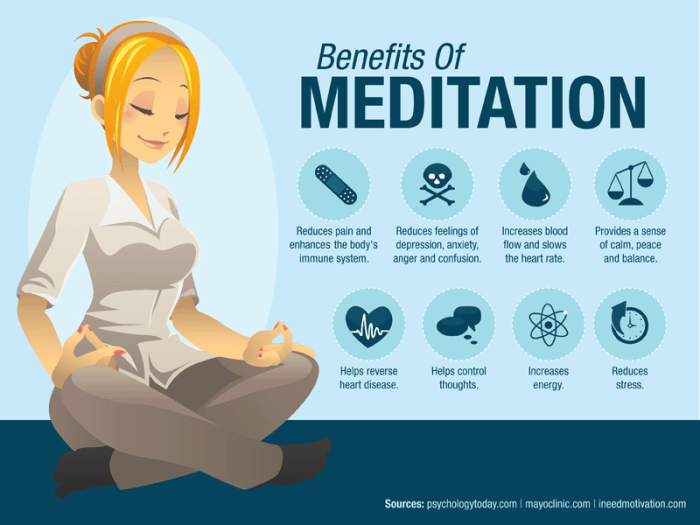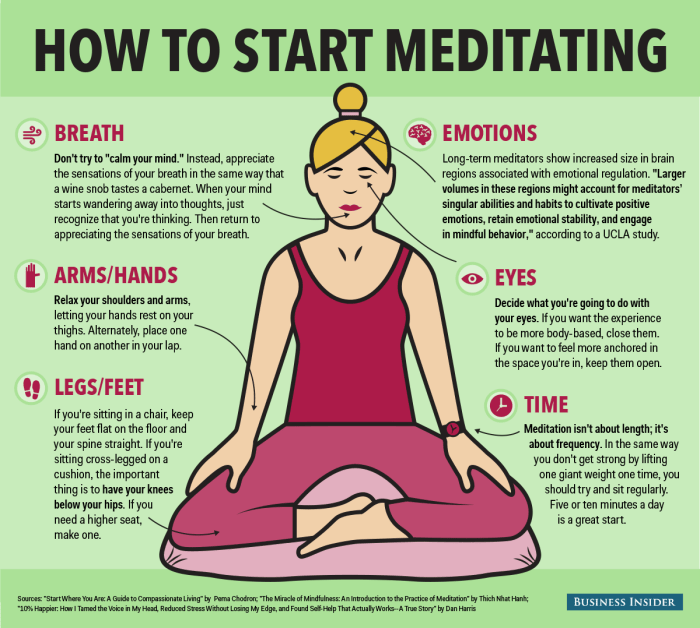Meditation for Beginners takes center stage, inviting you to explore the world of mindfulness with a fresh perspective. Get ready to embark on a journey towards self-discovery and tranquility.
In this guide, you’ll uncover the essentials of meditation, from understanding its benefits to practical tips on incorporating mindfulness into your daily routine.
Introduction to Meditation
Meditation is a practice that involves focusing the mind on a particular object, thought, or activity to achieve a state of mental clarity and emotional calmness. For beginners, meditation can be a powerful tool to reduce stress, improve concentration, and promote overall well-being.
Benefits of Meditation for Beginners
- Reduces Stress: Meditation helps calm the mind and body, reducing the levels of stress hormones in the body.
- Improves Focus: By practicing meditation regularly, beginners can enhance their ability to concentrate and stay present in the moment.
- Enhances Emotional Well-being: Meditation can help beginners manage their emotions better and develop a more positive outlook on life.
Types of Meditation Techniques

When it comes to meditation, there are various techniques that beginners can explore to find what suits them best.
Mindfulness Meditation
- Mindfulness meditation involves focusing on the present moment without judgment.
- Practitioners pay attention to their thoughts, sensations, and emotions as they arise.
- One common practice is focusing on the breath to anchor oneself in the present.
- Benefits include stress reduction, improved focus, and increased self-awareness.
Loving-Kindness Meditation
- Loving-kindness meditation focuses on cultivating feelings of compassion and love towards oneself and others.
- Practitioners repeat phrases of goodwill and visualize sending positive energy to themselves and others.
- This practice can enhance empathy, reduce negative emotions, and promote well-being.
Body Scan Meditation
- Body scan meditation involves bringing awareness to different parts of the body, usually starting from the toes and moving upward.
- Practitioners observe sensations without judgment and release tension in each body part.
- This technique can help with relaxation, stress relief, and body awareness.
Setting Up a Meditation Space: Meditation For Beginners

Creating a dedicated meditation space at home is crucial for establishing a consistent practice and fostering a sense of calm and focus. By having a designated area for meditation, you signal to your mind that it’s time to unwind and connect with yourself.
Essential Elements for a Peaceful Meditation Space, Meditation for Beginners
When setting up your meditation space, consider the following essential elements:
- A comfortable cushion or mat to sit on, ensuring proper posture and support during meditation.
- Soft lighting, such as candles or dimmable lamps, to create a soothing ambiance and reduce distractions.
- Calming decor like plants, crystals, or inspirational quotes to inspire tranquility and mindfulness.
- Minimal clutter to promote a sense of spaciousness and clarity in your meditation area.
Tips on Personalizing the Meditation Space
Personalizing your meditation space can enhance your practice and make it more enjoyable. Here are some tips to personalize your meditation space:
- Add personal items that hold special meaning to you, such as photos, artwork, or mementos.
- Incorporate elements from nature, like seashells or rocks, to evoke a sense of grounding and connection to the earth.
- Experiment with different scents, such as incense or essential oils, to create a sensory experience that enhances relaxation.
- Play soft background music or nature sounds to deepen your meditation experience and drown out external noise.
Developing a Meditation Routine
Establishing a consistent meditation routine is crucial for beginners as it helps in forming a habit and reaping the full benefits of meditation practice. By meditating at the same time each day, you signal to your mind and body that it’s time to relax and focus, making it easier to get into a meditative state.
Setting Realistic Goals
- Start with a realistic frequency: Begin with meditating for just a few minutes each day and gradually increase as you become more comfortable.
- Set achievable duration: Aim for a duration that you can commit to daily, whether it’s 5 minutes or 20 minutes.
- Be flexible: Allow yourself to adjust your goals based on your schedule and progress, without being too hard on yourself.
Staying Motivated and Overcoming Challenges
- Find a meditation buddy: Having a friend or partner to meditate with can keep you motivated and hold you accountable.
- Use guided meditations: Listening to guided meditations can help keep you focused and engaged, especially when starting out.
- Track your progress: Keep a meditation journal to note down your thoughts, feelings, and any challenges you face, as well as your achievements.
- Stay positive: Remember that meditation is a journey, and it’s okay to have off days. Be kind to yourself and keep practicing.
Mindfulness in Daily Activities
Integrating mindfulness into daily activities can help beginners enhance their awareness and presence throughout the day. By practicing mindfulness, individuals can focus on the present moment and cultivate a sense of calm and clarity in their everyday lives.
Eating Mindfully
- Take time to savor each bite of food, paying attention to the flavors, textures, and sensations.
- Avoid distractions such as watching TV or scrolling through your phone while eating.
- Chew slowly and mindfully, appreciating the nourishment that food provides to your body.
Walking Mindfully
- Focus on each step you take, feeling the ground beneath your feet and the movement of your body.
- Pay attention to your surroundings, noticing the sights, sounds, and smells as you walk.
- Breathe deeply and rhythmically as you walk, syncing your breath with your steps.
Mindful Chores
- Approach chores with a sense of mindfulness, focusing on the task at hand and the sensations involved.
- Engage all your senses while doing chores, noticing the sights, sounds, smells, and textures around you.
- Take breaks to pause and breathe mindfully, allowing yourself to reset and refocus on the present moment.
